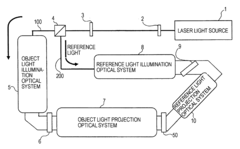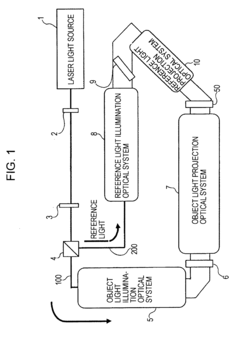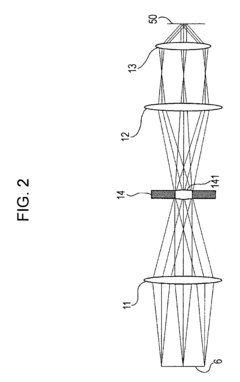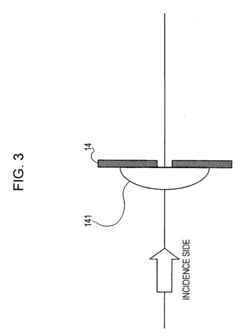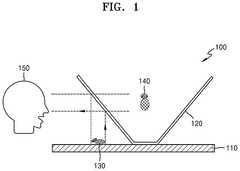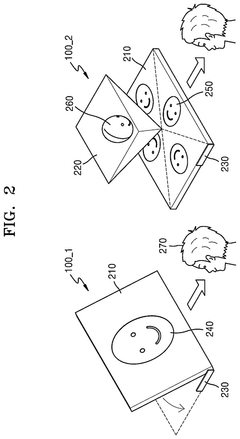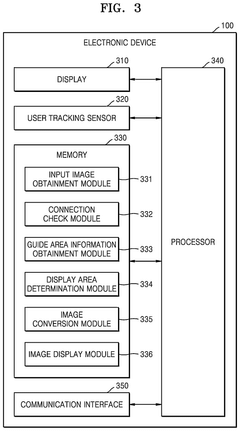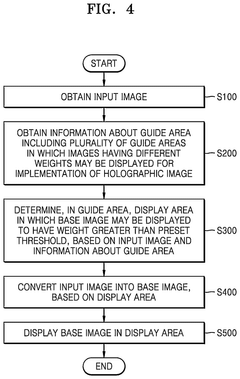Exploring holographic projections in laryngoscope training modules.
JUL 14, 20259 MIN READ
Generate Your Research Report Instantly with AI Agent
Patsnap Eureka helps you evaluate technical feasibility & market potential.
Holographic Laryngoscopy: Background and Objectives
Holographic laryngoscopy represents a groundbreaking fusion of advanced visualization technology and medical training. This innovative approach leverages holographic projections to create immersive and interactive learning environments for medical professionals practicing laryngoscopy techniques. The technology has evolved from traditional training methods, which often relied on static models or limited simulation tools, to a dynamic, three-dimensional experience that closely mimics real-world scenarios.
The development of holographic laryngoscopy is rooted in the broader context of medical simulation and augmented reality applications in healthcare. As the demand for more effective and efficient medical training continues to grow, holographic technology has emerged as a promising solution to bridge the gap between theoretical knowledge and practical skills acquisition. This advancement aligns with the ongoing digital transformation in medical education and the increasing emphasis on patient safety through improved practitioner competence.
The primary objective of exploring holographic projections in laryngoscope training modules is to enhance the quality and effectiveness of medical education. By providing a highly detailed and manipulable 3D representation of the larynx and surrounding structures, holographic technology aims to improve trainees' spatial awareness, hand-eye coordination, and procedural confidence. This, in turn, is expected to lead to better patient outcomes and reduced complications during actual laryngoscopy procedures.
Another key goal is to standardize and scale up laryngoscopy training. Holographic modules offer the potential for consistent, reproducible training experiences that can be easily distributed across medical institutions. This standardization is crucial for maintaining high-quality healthcare delivery and ensuring that all practitioners receive uniform, high-fidelity training regardless of their geographical location or institutional resources.
Furthermore, the integration of holographic technology in laryngoscopy training seeks to address the limitations of traditional training methods. These limitations include the lack of real-time feedback, the inability to simulate a wide range of anatomical variations and pathological conditions, and the challenges in providing repeated practice opportunities without patient risk. Holographic projections aim to overcome these obstacles by offering a safe, versatile, and highly customizable training platform.
As we explore this technology, it is essential to consider its potential to revolutionize not only laryngoscopy training but also other areas of medical education and practice. The insights gained from developing and implementing holographic laryngoscopy modules could pave the way for broader applications in surgical training, diagnostic imaging interpretation, and patient education.
The development of holographic laryngoscopy is rooted in the broader context of medical simulation and augmented reality applications in healthcare. As the demand for more effective and efficient medical training continues to grow, holographic technology has emerged as a promising solution to bridge the gap between theoretical knowledge and practical skills acquisition. This advancement aligns with the ongoing digital transformation in medical education and the increasing emphasis on patient safety through improved practitioner competence.
The primary objective of exploring holographic projections in laryngoscope training modules is to enhance the quality and effectiveness of medical education. By providing a highly detailed and manipulable 3D representation of the larynx and surrounding structures, holographic technology aims to improve trainees' spatial awareness, hand-eye coordination, and procedural confidence. This, in turn, is expected to lead to better patient outcomes and reduced complications during actual laryngoscopy procedures.
Another key goal is to standardize and scale up laryngoscopy training. Holographic modules offer the potential for consistent, reproducible training experiences that can be easily distributed across medical institutions. This standardization is crucial for maintaining high-quality healthcare delivery and ensuring that all practitioners receive uniform, high-fidelity training regardless of their geographical location or institutional resources.
Furthermore, the integration of holographic technology in laryngoscopy training seeks to address the limitations of traditional training methods. These limitations include the lack of real-time feedback, the inability to simulate a wide range of anatomical variations and pathological conditions, and the challenges in providing repeated practice opportunities without patient risk. Holographic projections aim to overcome these obstacles by offering a safe, versatile, and highly customizable training platform.
As we explore this technology, it is essential to consider its potential to revolutionize not only laryngoscopy training but also other areas of medical education and practice. The insights gained from developing and implementing holographic laryngoscopy modules could pave the way for broader applications in surgical training, diagnostic imaging interpretation, and patient education.
Market Analysis for Advanced Medical Training Tools
The market for advanced medical training tools, particularly those incorporating holographic projections in laryngoscope training modules, is experiencing significant growth and transformation. This trend is driven by the increasing demand for more effective and immersive training methods in medical education, especially in the field of anesthesiology and emergency medicine.
The global medical simulation market, which encompasses advanced training tools, is projected to reach substantial value in the coming years. This growth is fueled by factors such as the rising emphasis on patient safety, the need for cost-effective training solutions, and the growing adoption of simulation-based training in medical curricula.
Specifically, the market for laryngoscope training modules is witnessing a shift towards more sophisticated technologies. Traditional training methods, while still prevalent, are gradually being supplemented or replaced by advanced solutions that offer enhanced realism and interactivity. Holographic projections represent a cutting-edge development in this space, offering unprecedented levels of visual fidelity and spatial awareness for trainees.
The demand for these advanced training tools is particularly strong in developed healthcare markets such as North America and Europe, where there is a greater willingness to invest in innovative medical education technologies. However, emerging markets in Asia-Pacific and Latin America are also showing increasing interest, driven by the modernization of medical education systems and the growing recognition of the importance of simulation-based training.
Key market segments for holographic laryngoscope training modules include medical schools, teaching hospitals, and simulation centers. These institutions are increasingly recognizing the value of high-fidelity simulation in preparing healthcare professionals for real-world scenarios. The market is also seeing interest from emergency medical services and military medical units, where rapid and effective airway management training is crucial.
Despite the promising outlook, the market faces certain challenges. The high initial cost of implementing holographic projection systems can be a barrier for some institutions, particularly in resource-constrained settings. Additionally, there is a need for standardization and validation of these new training methodologies to ensure their effectiveness and acceptance within the medical community.
Looking ahead, the market for advanced medical training tools, including holographic laryngoscope modules, is expected to continue its growth trajectory. Factors such as the increasing focus on competency-based medical education, the need for remote learning solutions in the wake of global health crises, and ongoing technological advancements in augmented and virtual reality are likely to drive further innovation and adoption in this space.
The global medical simulation market, which encompasses advanced training tools, is projected to reach substantial value in the coming years. This growth is fueled by factors such as the rising emphasis on patient safety, the need for cost-effective training solutions, and the growing adoption of simulation-based training in medical curricula.
Specifically, the market for laryngoscope training modules is witnessing a shift towards more sophisticated technologies. Traditional training methods, while still prevalent, are gradually being supplemented or replaced by advanced solutions that offer enhanced realism and interactivity. Holographic projections represent a cutting-edge development in this space, offering unprecedented levels of visual fidelity and spatial awareness for trainees.
The demand for these advanced training tools is particularly strong in developed healthcare markets such as North America and Europe, where there is a greater willingness to invest in innovative medical education technologies. However, emerging markets in Asia-Pacific and Latin America are also showing increasing interest, driven by the modernization of medical education systems and the growing recognition of the importance of simulation-based training.
Key market segments for holographic laryngoscope training modules include medical schools, teaching hospitals, and simulation centers. These institutions are increasingly recognizing the value of high-fidelity simulation in preparing healthcare professionals for real-world scenarios. The market is also seeing interest from emergency medical services and military medical units, where rapid and effective airway management training is crucial.
Despite the promising outlook, the market faces certain challenges. The high initial cost of implementing holographic projection systems can be a barrier for some institutions, particularly in resource-constrained settings. Additionally, there is a need for standardization and validation of these new training methodologies to ensure their effectiveness and acceptance within the medical community.
Looking ahead, the market for advanced medical training tools, including holographic laryngoscope modules, is expected to continue its growth trajectory. Factors such as the increasing focus on competency-based medical education, the need for remote learning solutions in the wake of global health crises, and ongoing technological advancements in augmented and virtual reality are likely to drive further innovation and adoption in this space.
Current Challenges in Holographic Laryngoscope Training
The integration of holographic projections into laryngoscope training modules presents several significant challenges that need to be addressed for effective implementation. One of the primary obstacles is the high cost associated with developing and deploying holographic technology in medical education settings. The sophisticated hardware and software required for realistic holographic projections can be prohibitively expensive for many institutions, limiting widespread adoption.
Another major challenge lies in achieving the necessary level of realism and accuracy in holographic representations of the laryngeal anatomy. Creating high-fidelity holographic images that accurately depict the intricate structures of the larynx and surrounding tissues requires advanced imaging techniques and powerful rendering capabilities. Any discrepancies between the holographic projection and real-world anatomy could potentially lead to inadequate training outcomes.
The issue of user interaction and haptic feedback presents a significant hurdle in holographic laryngoscope training. While visual representation is crucial, the tactile sensation of performing a laryngoscopy is equally important for skill development. Current holographic technologies often lack the ability to provide realistic tactile feedback, which is essential for trainees to develop proper technique and muscle memory.
Technical limitations in terms of field of view and depth perception also pose challenges. Holographic displays may struggle to provide the wide-angle view necessary for comprehensive laryngoscopic examination, potentially limiting the trainee's ability to visualize the entire relevant anatomical area. Additionally, achieving accurate depth perception in holographic projections is crucial for developing proper instrument handling skills.
The integration of holographic technology with existing medical training curricula and assessment methods presents another challenge. Developing standardized training protocols and evaluation criteria that effectively incorporate holographic elements requires significant effort and collaboration between medical educators and technology experts.
Ensuring the reliability and consistency of holographic projections across different training sessions and environments is also a concern. Variations in lighting conditions, viewing angles, and other environmental factors can potentially affect the quality and stability of holographic images, impacting the overall training experience.
Lastly, there are regulatory and safety considerations to address. As a novel technology in medical training, holographic laryngoscope simulators may need to undergo rigorous testing and certification processes to ensure they meet medical education standards and do not pose any risks to users or future patients.
Another major challenge lies in achieving the necessary level of realism and accuracy in holographic representations of the laryngeal anatomy. Creating high-fidelity holographic images that accurately depict the intricate structures of the larynx and surrounding tissues requires advanced imaging techniques and powerful rendering capabilities. Any discrepancies between the holographic projection and real-world anatomy could potentially lead to inadequate training outcomes.
The issue of user interaction and haptic feedback presents a significant hurdle in holographic laryngoscope training. While visual representation is crucial, the tactile sensation of performing a laryngoscopy is equally important for skill development. Current holographic technologies often lack the ability to provide realistic tactile feedback, which is essential for trainees to develop proper technique and muscle memory.
Technical limitations in terms of field of view and depth perception also pose challenges. Holographic displays may struggle to provide the wide-angle view necessary for comprehensive laryngoscopic examination, potentially limiting the trainee's ability to visualize the entire relevant anatomical area. Additionally, achieving accurate depth perception in holographic projections is crucial for developing proper instrument handling skills.
The integration of holographic technology with existing medical training curricula and assessment methods presents another challenge. Developing standardized training protocols and evaluation criteria that effectively incorporate holographic elements requires significant effort and collaboration between medical educators and technology experts.
Ensuring the reliability and consistency of holographic projections across different training sessions and environments is also a concern. Variations in lighting conditions, viewing angles, and other environmental factors can potentially affect the quality and stability of holographic images, impacting the overall training experience.
Lastly, there are regulatory and safety considerations to address. As a novel technology in medical training, holographic laryngoscope simulators may need to undergo rigorous testing and certification processes to ensure they meet medical education standards and do not pose any risks to users or future patients.
Existing Holographic Solutions for Laryngoscopy Training
01 Holographic display systems
Various systems and methods for creating holographic projections, including the use of spatial light modulators, laser light sources, and specialized optical components to generate three-dimensional images in space. These systems often employ advanced algorithms and hardware configurations to produce high-quality, realistic holographic displays for various applications.- Holographic display systems: Advanced holographic display systems utilize various technologies to create three-dimensional images in mid-air. These systems often incorporate spatial light modulators, laser light sources, and specialized optics to generate high-quality holographic projections. Some designs focus on improving image quality, while others aim to reduce system complexity and cost.
- Holographic projection methods: Various methods for creating holographic projections have been developed, including techniques for generating real-time dynamic holograms, computer-generated holograms, and methods for improving the viewing angle and resolution of holographic images. These methods often involve complex algorithms for light field manipulation and wavefront reconstruction.
- Holographic data storage and retrieval: Holographic technology is used for high-density data storage and retrieval systems. These systems use holographic techniques to store and read large amounts of data in three-dimensional optical media. Innovations in this area focus on increasing storage capacity, improving read/write speeds, and enhancing data reliability.
- Augmented and virtual reality applications: Holographic projection technology is increasingly being integrated into augmented and virtual reality systems. These applications use holographic optical elements and advanced projection techniques to create immersive experiences, heads-up displays, and interactive holographic interfaces for various industries including gaming, education, and professional training.
- Holographic projection devices: Compact and portable holographic projection devices have been developed for consumer and professional use. These devices often incorporate miniaturized optical components, advanced light sources, and innovative projection techniques to create holographic displays in various environments. Some designs focus on improving brightness, color reproduction, and energy efficiency.
02 Holographic recording and playback techniques
Techniques for recording and reproducing holographic images, including methods for capturing, storing, and reconstructing holographic data. This encompasses advancements in holographic storage media, data encoding algorithms, and optical systems for faithful reproduction of recorded holograms.Expand Specific Solutions03 Holographic projection in augmented and virtual reality
Integration of holographic projection technology into augmented and virtual reality systems, enabling more immersive and interactive experiences. This includes the development of compact, wearable holographic displays and methods for combining holographic elements with real-world environments.Expand Specific Solutions04 Holographic optical elements and waveguides
Design and fabrication of specialized optical components, such as holographic optical elements and waveguides, for use in holographic projection systems. These components enable more efficient light manipulation, improved image quality, and miniaturization of holographic display devices.Expand Specific Solutions05 Color holographic projection techniques
Methods for creating full-color holographic projections, including techniques for combining multiple wavelengths of light, color separation and recombination, and color management in holographic systems. These advancements aim to produce more vibrant and realistic holographic images with accurate color reproduction.Expand Specific Solutions
Key Players in Medical Holography and Simulation
The exploration of holographic projections in laryngoscope training modules is in its early stages, with the market still emerging and relatively small. However, it shows significant potential for growth as medical training increasingly adopts advanced visualization technologies. Companies like Envisics, Sony, and Massachusetts Institute of Technology are at the forefront, leveraging their expertise in holographic displays and imaging systems. The technology's maturity varies, with some players offering commercial products while others focus on research and development. As the technology advances, we can expect increased adoption in medical education and training, driving market expansion and attracting more players to this specialized field.
Envisics Ltd.
Technical Solution: Envisics Ltd. has applied its automotive holographic technology to medical training, including laryngoscope modules. Their system uses a proprietary holographic waveguide technology to create high-resolution, full-color 3D images with a wide field of view[1]. The holographic projections are generated using advanced algorithms that account for the viewer's position and eye movements, ensuring optimal image quality from multiple angles[3]. Envisics' technology also incorporates dynamic focus capabilities, allowing trainees to focus on different depths within the holographic image, mimicking the natural focusing process during laryngoscopy[5]. The system is designed to be compact and energy-efficient, making it suitable for integration into various training environments[7].
Strengths: Wide field of view, dynamic focusing capabilities, and energy-efficient design. Weaknesses: May require adaptation from automotive applications to meet specific medical training needs.
Sony Group Corp.
Technical Solution: Sony Group Corp. has developed a holographic projection system for medical training, including laryngoscopy. Their technology uses advanced light field displays to create high-fidelity 3D images without the need for special glasses[2]. The system employs a proprietary micro-lens array and high-speed image processing to generate holographic projections with a wide viewing angle and minimal crosstalk[4]. Sony's solution also incorporates eye-tracking technology to optimize the holographic image based on the viewer's position[6]. For laryngoscope training, the system can simulate various anatomical variations and pathological conditions, allowing trainees to practice on a wide range of virtual patients[8].
Strengths: High-quality glasses-free 3D visualization, wide viewing angle, and adaptability to different training scenarios. Weaknesses: May require significant computational power and specialized hardware.
Core Innovations in Medical Holographic Projections
Holographic stereogram creation device and its method
PatentInactiveUS20070019266A1
Innovation
- A convex lens is integrated into the unnecessary light removing slit at a conjugate position of the hologram recording material, ensuring light from the spatial light modulator becomes parallel, reducing blur without direct contact and potential damage.
Electronic device providing holographic image and operating method of electronic device
PatentPendingUS20250199471A1
Innovation
- An electronic device is designed with a processor that executes instructions to obtain an input image, determine a display area within a guide area based on the input image and guide area information, convert the input image into a base image, and display the base image in the determined area, ensuring optimal holographic image implementation.
Regulatory Framework for Medical Training Devices
The regulatory framework for medical training devices, including holographic laryngoscope simulators, is a complex and evolving landscape. In the United States, the Food and Drug Administration (FDA) plays a crucial role in overseeing these devices. Medical training simulators are typically classified as Class I or Class II medical devices, depending on their complexity and potential risks.
For holographic laryngoscope training modules, the FDA's Center for Devices and Radiological Health (CDRH) would likely be responsible for their regulation. These devices may fall under the 510(k) premarket notification process, requiring manufacturers to demonstrate that their device is substantially equivalent to a legally marketed predicate device.
In the European Union, the Medical Device Regulation (MDR) governs such devices. The MDR, which came into full effect in May 2021, has increased the regulatory requirements for medical devices, including those used for training purposes. Manufacturers must comply with stricter clinical evaluation and post-market surveillance requirements.
The International Medical Device Regulators Forum (IMDRF) has been working towards global harmonization of medical device regulations. Their guidance documents on Software as a Medical Device (SaMD) may be particularly relevant for holographic projection systems in medical training.
Safety standards for these devices are crucial. The IEC 60601 series of standards for medical electrical equipment and the ISO 13485 standard for quality management systems in medical devices are particularly relevant. Additionally, specific standards related to virtual reality and augmented reality in healthcare, such as IEEE P2048.5, are being developed.
Data protection regulations also play a significant role, especially if the training modules collect or process any personal data. In the EU, the General Data Protection Regulation (GDPR) would apply, while in the US, HIPAA regulations may be relevant if the device handles patient data during training scenarios.
Regulatory bodies are increasingly focusing on the validation of AI and machine learning algorithms in medical devices. If holographic laryngoscope training modules incorporate such technologies, manufacturers will need to address these emerging regulatory requirements.
As the field of medical simulation evolves, regulatory frameworks are likely to adapt. Manufacturers and developers of holographic laryngoscope training modules must stay informed about these changes and engage proactively with regulatory bodies to ensure compliance and facilitate innovation in this promising field of medical education.
For holographic laryngoscope training modules, the FDA's Center for Devices and Radiological Health (CDRH) would likely be responsible for their regulation. These devices may fall under the 510(k) premarket notification process, requiring manufacturers to demonstrate that their device is substantially equivalent to a legally marketed predicate device.
In the European Union, the Medical Device Regulation (MDR) governs such devices. The MDR, which came into full effect in May 2021, has increased the regulatory requirements for medical devices, including those used for training purposes. Manufacturers must comply with stricter clinical evaluation and post-market surveillance requirements.
The International Medical Device Regulators Forum (IMDRF) has been working towards global harmonization of medical device regulations. Their guidance documents on Software as a Medical Device (SaMD) may be particularly relevant for holographic projection systems in medical training.
Safety standards for these devices are crucial. The IEC 60601 series of standards for medical electrical equipment and the ISO 13485 standard for quality management systems in medical devices are particularly relevant. Additionally, specific standards related to virtual reality and augmented reality in healthcare, such as IEEE P2048.5, are being developed.
Data protection regulations also play a significant role, especially if the training modules collect or process any personal data. In the EU, the General Data Protection Regulation (GDPR) would apply, while in the US, HIPAA regulations may be relevant if the device handles patient data during training scenarios.
Regulatory bodies are increasingly focusing on the validation of AI and machine learning algorithms in medical devices. If holographic laryngoscope training modules incorporate such technologies, manufacturers will need to address these emerging regulatory requirements.
As the field of medical simulation evolves, regulatory frameworks are likely to adapt. Manufacturers and developers of holographic laryngoscope training modules must stay informed about these changes and engage proactively with regulatory bodies to ensure compliance and facilitate innovation in this promising field of medical education.
Cost-Benefit Analysis of Holographic Training Systems
The implementation of holographic projections in laryngoscope training modules represents a significant technological advancement in medical education. However, to fully understand its potential impact, a comprehensive cost-benefit analysis is essential. This analysis considers both the financial implications and the educational outcomes of integrating holographic training systems into medical curricula.
From a cost perspective, the initial investment in holographic technology can be substantial. High-quality holographic projection systems, including hardware and software components, require significant upfront capital expenditure. Additionally, there are ongoing costs associated with maintenance, updates, and technical support. The development of specialized holographic content for laryngoscope training further adds to the overall expense.
However, these costs must be weighed against the potential long-term benefits and savings. Traditional laryngoscope training often involves the use of expensive mannequins and physical models, which have limited lifespans and require regular replacement. Holographic systems, while initially more expensive, offer greater durability and the ability to simulate a wider range of scenarios without physical wear and tear.
The educational benefits of holographic training systems are significant. They provide a more immersive and interactive learning experience, allowing trainees to visualize complex anatomical structures in three dimensions. This enhanced visualization can lead to improved understanding and retention of critical concepts. Furthermore, holographic systems can simulate a variety of patient scenarios and complications, providing a broader range of training experiences than traditional methods.
Another key benefit is the potential for remote training. Holographic systems can facilitate distance learning, reducing the need for travel and allowing institutions to share resources more efficiently. This can result in substantial cost savings over time, particularly for institutions with multiple campuses or those in remote locations.
The scalability of holographic training systems also contributes to their cost-effectiveness. Once developed, holographic content can be easily distributed and updated across multiple training centers, maximizing the return on investment. This scalability extends to the number of students who can benefit from the technology, as holographic projections can be viewed by multiple trainees simultaneously without the need for individual physical models.
In terms of outcomes, early studies suggest that holographic training can lead to faster skill acquisition and improved performance in real-world clinical settings. This could potentially reduce the overall training time required for proficiency in laryngoscopy, translating to cost savings in terms of instructor time and resources. Moreover, the improved skill levels of trainees may lead to better patient outcomes, indirectly reducing healthcare costs associated with complications or extended hospital stays.
From a cost perspective, the initial investment in holographic technology can be substantial. High-quality holographic projection systems, including hardware and software components, require significant upfront capital expenditure. Additionally, there are ongoing costs associated with maintenance, updates, and technical support. The development of specialized holographic content for laryngoscope training further adds to the overall expense.
However, these costs must be weighed against the potential long-term benefits and savings. Traditional laryngoscope training often involves the use of expensive mannequins and physical models, which have limited lifespans and require regular replacement. Holographic systems, while initially more expensive, offer greater durability and the ability to simulate a wider range of scenarios without physical wear and tear.
The educational benefits of holographic training systems are significant. They provide a more immersive and interactive learning experience, allowing trainees to visualize complex anatomical structures in three dimensions. This enhanced visualization can lead to improved understanding and retention of critical concepts. Furthermore, holographic systems can simulate a variety of patient scenarios and complications, providing a broader range of training experiences than traditional methods.
Another key benefit is the potential for remote training. Holographic systems can facilitate distance learning, reducing the need for travel and allowing institutions to share resources more efficiently. This can result in substantial cost savings over time, particularly for institutions with multiple campuses or those in remote locations.
The scalability of holographic training systems also contributes to their cost-effectiveness. Once developed, holographic content can be easily distributed and updated across multiple training centers, maximizing the return on investment. This scalability extends to the number of students who can benefit from the technology, as holographic projections can be viewed by multiple trainees simultaneously without the need for individual physical models.
In terms of outcomes, early studies suggest that holographic training can lead to faster skill acquisition and improved performance in real-world clinical settings. This could potentially reduce the overall training time required for proficiency in laryngoscopy, translating to cost savings in terms of instructor time and resources. Moreover, the improved skill levels of trainees may lead to better patient outcomes, indirectly reducing healthcare costs associated with complications or extended hospital stays.
Unlock deeper insights with Patsnap Eureka Quick Research — get a full tech report to explore trends and direct your research. Try now!
Generate Your Research Report Instantly with AI Agent
Supercharge your innovation with Patsnap Eureka AI Agent Platform!
